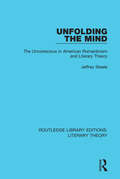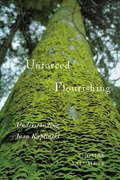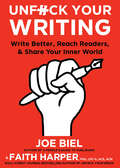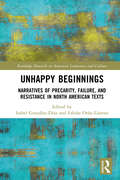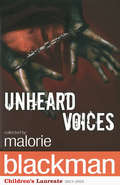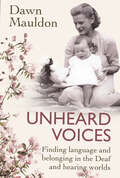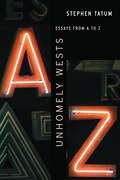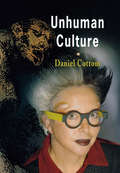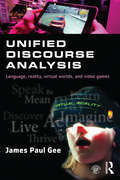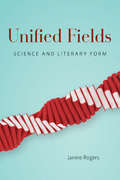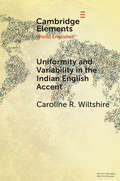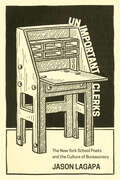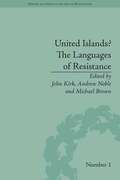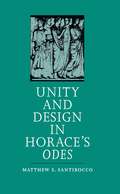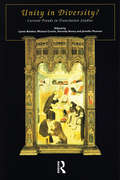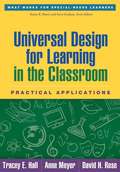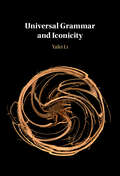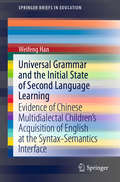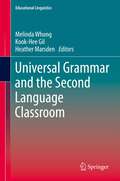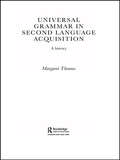- Table View
- List View
Unfolding the Mind: The Unconscious in American Romanticism and Literary Theory (Routledge Library Editions: Literary Theory)
by Jeffrey SteeleAmerican writers in the 1830s and 1840s felt the need for a new terminology to express their awakening perception of "new" aspects of the mind. Without words like the "unconscious" vast areas of the psyche would have remained unexpressed and thus unapproachable. This "discovery" of the unconscious constitutes to the theme of this study, which was first published in 1987. This title will be of interest to students of literary theory.
Unforced Flourishing
by Thomas SalumetsAre we ill-suited for this world? Among Europe's major contemporary poets, Estonia's Jaan Kaplinski offers a rare vision of human advancement and fulfillment: the less we intervene the more we flourish. But how then can we remain involved in what evolves of its own accord? How can we move away from a life forged by human design towards a quietly attentive yet spontaneous responsiveness? In Unforced Flourishing, Thomas Salumets seeks access to Kaplinski's life and work and finds a path to the signature of his thinking. He uncovers a man who craves human closeness that few, if any, can provide, a writer drawn towards wordless communication in a world of words, signs, and symbols, who yearns for the sacred in secular times, and who detects more richness in nature than in the human imagination. Salumets describes Kaplinski as an intellectual attracted to a contrarian sense of self, art, and culture, who searches for his homeland's mystical connections at a time when Estonia firmly aligns with values and modes of thought vastly different from his own. What emerges is a mentality firmly rooted in the belief that the greatest risk to human fulfillment results from human beings themselves. The first major study in English of one of Eastern Europe's most important literary figures, Unforced Flourishing details Kaplinski's embrace of that which is undifferentiated, intuitive, non-calculative, and natural in the modern world.
Unforced Flourishing: Understanding Jaan Kaplinski
by Thomas SalumetsAre we ill-suited for this world? Among Europe's major contemporary poets, Estonia's Jaan Kaplinski offers a rare vision of human advancement and fulfillment: the less we intervene the more we flourish. But how then can we remain involved in what evolves of its own accord? How can we move away from a life forged by human design towards a quietly attentive yet spontaneous responsiveness? In Unforced Flourishing, Thomas Salumets seeks access to Kaplinski's life and work and finds a path to the signature of his thinking. He uncovers a man who craves human closeness that few, if any, can provide, a writer drawn towards wordless communication in a world of words, signs, and symbols, who yearns for the sacred in secular times, and who detects more richness in nature than in the human imagination. Salumets describes Kaplinski as an intellectual attracted to a contrarian sense of self, art, and culture, who searches for his homeland's mystical connections at a time when Estonia firmly aligns with values and modes of thought vastly different from his own. What emerges is a mentality firmly rooted in the belief that the greatest risk to human fulfillment results from human beings themselves. The first major study in English of one of Eastern Europe's most important literary figures, Unforced Flourishing details Kaplinski’s embrace of that which is undifferentiated, intuitive, non-calculative, and natural in the modern world.
Unfuck Your Writing: Write Better, Reach Readers, & Share Your Inner World
by Joe Biel Faith G. Harper, PhD, LPC-S, ACS, ACNWant to be a writer, but the words won't come? Do you have a lot to say but don't know how to write it so people will read it? Do you struggle with anxiety, procrastination, or feeling like an imposter around your writing? Microcosm's two most prolific authors teach you their tricks of the trade in this no-nonsense, practical guide to the craft of writing longform work. Learn skills like setting and sticking to goals, communicating effectively with your writing, having fun while writing, working with an editor, and creating reader-oriented work. This is not a book about crafting beautiful sentences with perfect grammar; instead Harper and Biel will teach you to write so that your words have the greatest possible impact on the world.
Unhappy Beginnings: Narratives of Precarity, Failure, and Resistance in North American Texts (Routledge Research in American Literature and Culture)
by Isabel González-Díaz Fabián Orán-LlarenaThis book offers the analysis of a selection of North American texts that dismantle and resist normative frames through the resignification of concepts such as unhappiness, precarity, failure, and vulnerability. The chapters bring to the fore how those potentially negative elements can be refigured as ambivalent sites of resistance and social bonding. Following Sara Ahmed’s rereading of happiness, other authors such as Judith Butler, Wendy Brown, Jack Halberstam, Lauren Berlant, or Henry Giroux are mobilized to interrogate films, memoirs, and novels that deal with precarity, alienation, and inequality. The monograph contributes to enlarging the archives of unhappiness by changing the focus from prescribed norms and happy endings to unruly practices and unhappy beginnings. As the different contributors show, unhappiness, precarity, vulnerability, or failure can be harnessed to illuminate ways of navigating the world and framing society that do not necessarily conform to the script of happiness—whatever that means.
Unheard Voices: An Anthology of Stories and Poems to Commemorate the Bicentenary Anniversary of the Abolition of the Slave Trade
by Malorie BlackmanIn March 1807, the British Parliament passed an Act making the trading and transportation of slaves illegal. It was many years before slavery, as it was known then, was abolished, and slavery still continues today in different ways, but it was a big step forward towards the empancipation of a people. Malorie Blackman has drawn together some of the finest of today's writers and poets to contribute to this important anthology. Their short stories and poems sit alongside first-hand accounts of slavery from freed slaves, making a fascinating and absorbing collection that remembers and commemorates one of the most brutal and long-lasting inflictions of misery that human beings have inflicted upon other human beings.
Unheard Voices: Finding language and belonging in the Deaf and hearing worlds
by Dawn MauldonIn this poignant and powerful memoir, the author tells the story of their childhood growing up with Deaf parents. Through intimate and evocative prose, Dawn explores the challenges and joys of living in a world that is often hostile and unwelcoming to those who are different.From the isolation and challenges that come with being a child of Deaf parents, to the strength and resilience that comes with love and belonging, the author shares their unique and deeply personal perspective on what it means to see and communicate in a richly silent world.This book is a must-read for anyone interested in the Deaf experience, and the power of love and belonging to overcome adversity. Beautifully written and deeply moving, Unheard Voices is an exploration of what it means to be a part of a diverse and vibrant culture.
Unhomely Wests: Essays from A to Z (Postwestern Horizons)
by Stephen TatumIn Unhomely Wests Stephen Tatum presents twenty-six essays exploring selected literary, visual art, cinematic, and musical representations of homelessness as a theme, a trope, an affliction, a threat, and a condition of alienation in the late modern and postmodern American West. Arranged in alphabetical order, from &“Alphabet/Abecedario&” to &“Zombieland,&” Tatum&’s essays aim to discover how his eclectic selection of texts both produce uncanny literary effects and bear witness to the entangled capitalist, geopolitical, and ecological crises that shape our external world and our &“unhomely&” textual worlds. In keeping with the etymological and conceptual linkage between the unhomely and the uncanny, Tatum&’s critical meditations focus on both uncanny textual architectures and architecturally unhomely junkspaces of abandonment and ruin, of corporeal displacement, and of cognitive or affective disorientation. And since an emergent unhomely structure of feeling exposes how our lived present is saturated with history&’s apparitional revenants, this collection of essays—comprising a new lexicon of unhomely Wests—conveys a hauntology underwritten by spectrality as a theme, a trope, an image. Committed to revising the conventional academic text, Unhomely Wests exemplifies Roland Barthes&’s directive that we consider the alphabetic order as a call to &“Cut! Resume the story in another way!&”
Unhuman Culture
by Daniel CottomIt is widely acknowledged that the unhuman plays a significant role in the definition of humanity in contemporary thought. It appears in the thematization of "the Other" in philosophical, psychoanalytic, anthropological, and postcolonial studies, and shows up in the "antihumanism" associated with figures such as Heidegger, Foucault, and Derrida. One might trace its genealogy, as Freud did, to the Copernican, Darwinian, and psychoanalytic revolutions that displaced humanity from the center of the universe. Or as Karl Marx and others suggested, one might lose human identity in the face of economic, technological, political, and ideological forces and structures.With dazzling breadth, wit, and intelligence, Unhuman Culture ranges over literature, art, and theory, ancient to postmodern, to explore the ways in which contemporary culture defines humanity in terms of all that it is not. Daniel Cottom is equally at home reading medieval saints' lives and the fiction of Angela Carter, plumbing the implications of Napoleon's self-coronation and the attacks of 9/11, considering the paintings of Pieter Bruegel and the plastic-surgery-as-performance of the body artist Orlan.For Cottom, the unhuman does not necessarily signify the inhuman, in the sense of conspicuous or extraordinary cruelty. It embraces, too, the superhuman, the supernatural, the demonic, and the subhuman; the supposedly disjunctive animal, vegetable, and mineral kingdoms; the realms of artifice, technology, and fantasy. It plays a role in theoretical discussions of the sublime, personal memoirs of the Holocaust, aesthetic reflections on technology, economic discourses on globalization, and popular accounts of terrorism. Whereas it once may have seemed that the concept of culture always, by definition, pertained to humanity, it now may seem impossible to avoid the realization that we must look at things differently. It is not only art, in the narrow sense of the word, that we must recognize as unhuman. For better or worse, ours is now an unhuman culture.
Unified Discourse Analysis: Language, Reality, Virtual Worlds and Video Games
by James Paul GeeDiscourse Analysis is becoming increasingly "multimodal", concerned primarily with the interplay of language, image and sound. Video Games allow humans to create, live in and have conversations with new multimodal worlds. In this ground-breaking new textbook, best-selling author and experienced gamer, James Paul Gee, sets out a new theory and method of discourse analysis which applies to language, the real world, science and video games. Rather than analysing the language of video games, this book uses discourse analysis to study games as communicational forms. Gee argues that language, science, games and everyday life are deeply related and each is a series of conversations. Discourse analysis should not be just about language, but about human interactions with the world, with games, and with each other, interactions that make meaning and sustain lives amid risk and complexity. Written in a highly accessible style and drawing on a wide range of video games from World of Warcraft and Chibi-Robo to Tetris, this engaging textbook is essential reading for students in discourse analysis, new media and digital culture.
Unified Fields
by Janine RogersLiterary form presents an important opportunity for understanding the relationship between literature and science. Through a series of close readings of poetry and prose, Unified Fields demonstrates that formal structures in literature can relate to scientific concepts through their essential interpretive functions. Janine Rogers engages with a wide range of writing from Canadian, British, and American authors, including the poetry of Elizabeth Bishop and Robyn Sarah as well as prose by Margaret Atwood, Ian McEwan, and Stephen Hawking. She employs an interdisciplinary approach combining formalist, historical, and theoretical literary practice, informed by interpretive frameworks developed in the philosophy of science. Although dedicated to contemporary texts, Rogers's analysis is frequently rooted in historical contexts of form, including Euclidean geometry and medieval romance, developed when the distinction between literature and science was not so drastic. These historical connections demonstrate that continuities of form resonate in both contemporary literature and science. Through critical analysis and engaging prose, Unified Fields bridges an important disciplinary gap by revealing how literary practice informs scientific understanding.
Unified Fields: Science and Literary Form
by Janine RogersLiterary form presents an important opportunity for understanding the relationship between literature and science. Through a series of close readings of poetry and prose, Unified Fields demonstrates that formal structures in literature can relate to scientific concepts through their essential interpretive functions. Janine Rogers engages with a wide range of writing from Canadian, British, and American authors, including the poetry of Elizabeth Bishop and Robyn Sarah as well as prose by Margaret Atwood, Ian McEwan, and Stephen Hawking. She employs an interdisciplinary approach combining formalist, historical, and theoretical literary practice, informed by interpretive frameworks developed in the philosophy of science. Although dedicated to contemporary texts, Rogers's analysis is frequently rooted in historical contexts of form, including Euclidean geometry and medieval romance, developed when the distinction between literature and science was not so drastic. These historical connections demonstrate that continuities of form resonate in both contemporary literature and science. Through critical analysis and engaging prose, Unified Fields bridges an important disciplinary gap by revealing how literary practice informs scientific understanding.
Uniformity and Variability in the Indian English Accent (Elements in World Englishes)
by Caroline R. WiltshireThe sounds of Indian English are distinct and recognizable to outsiders, while insiders perceive variations in how English has developed in this large diverse population. What characteristics mark the unity? Which are clues to a speaker's origins or identity? This Element synthesizes research over the past fifty years and adds to it, focusing on selected features of consonants, vowels, and suprasegmentals (stress, intonation, rhythm) to understand the characteristics of Indian English accents and sources of its uniformity and variability. These accent features, perceptible by humans and discoverable by computational approaches, may be used in expressing identity, both local and pan-Indian.
Unimportant Clerks: The New York School Poets and the Culture of Bureaucracy
by Jason LagapaExamines the ambivalent, often critical relationship of the New York School poets to bureaucratic culture and the conditions of work.Unimportant Clerks identifies a central tension in the writing of the New York School poets: at times their poetry replicates the ideology of bureaucracy while at others—and more persistently—it repudiates related principles of efficiency, routine, and regimentation. Frank O'Hara, John Ashberry, Barbara Guest, James Schuyler, and Eileen Myles each had a clerical or secretarial job at the start of their professional careers. Heirs to Melville's Bartleby and antecedents of our own era of "quiet quitting," they by necessity channeled their creativity into everyday practices of refusing work. Drawing on a range of anti-work traditions, movements, and theories, Unimportant Clerks shows how their poetry reflects and contests a midcentury administrative ethos, anticipating contemporary critiques of precarity and the demands of office work.
Unison Reading: Socially Inclusive Group Instruction for Equity and Achievement
by Cynthia MccallisterUnison Reading engages students as they read content aloud in small, diverse groups. Results include increased equity, social engagement, collaborative learning, and student achievement.
United Islands? The Languages of Resistance (Poetry and Song in the Age of Revolution #1)
by John KirkThis is the first title in a new series called Poetry and Song in the Age of Revolution. This series will appeal to those involved in English literary studies, as well as those working in fields of study that cover Enlightenment, Romanticism and Revolution in the last quarter of the eighteenth century.
United States Government: Democracy in Action, Guided Reading Activities
by McGraw-Hill StaffThe United States Government: Democracy in Action Guided Reading Activities provides activities for students who would benefit from a review of the material. By focusing on key information and concepts, Guided Reading Activities help students to understand and make appropriate connections among the ideas and facts they encounter in the student text.
Unity and Design in Horace's Odes
by Matthew S. SantiroccoHorace's first three books of Odes, published together in 23 B.C., are a masterpiece of Augustan literature and the culmination of classical lyric. Matthew Santirocco provides the first new critical approach to them in English in more than two decades.Drawing on recent works on ancient and modern poetry books and using several contemporary critical methodologies, Santirocco reveals the Odes both as individual poems and as components in a larger poetic design. His reading of Horace demonstrates that the ensemble is itself an important context for understanding and appreciating the poetry.Reconstructing the history of the ancient poetry book, both Greek and Roman, Santirocco challenges certain common assumptions about its origin and development. He argues that true parallels for the Odes are not to be found in the other Augustan books, which are relatively homogeneous in content and form, but in the heterogeneous collections of Hellenistic writers.Odes I-III comprise eighty-eight poems in twelve different meters, and in tone and topic they vary widely. Avoiding the two extremes of past scholarship, which either has searched for a single underlying unity or else has denied any meaningful design, Santirocco uncovers a variety of both static and dynamic structures and shows their relevance to the literary interpretation of the poems at all levels. Ultimately, the composition of a poem and the disposition of the group are shown to be analogous activities. Odes I-III do not constitute a medley of discrete poems but, instead, approximate the unity of a single ode.
Unity in Diversity: Current Trends in Translation Studies
by Lynne Bowker Michael Cronin Jennifer Pearson Dorothy KennyTranslation studies as a discipline has grown enormously in recent decades. Contributions to the discipline have come from a variety of fields, including machine translation, history, literature, philosophy, linguistics, terminology, signed language interpreting, screen translation, translation pedagogy, software localization and lexicography. There is evidently great diversity in translation studies, but is there much unity? Have the different branches of translation studies become so specialized that they can no longer talk to each other? Would translation studies be strengthened or weakened by the search for or the existence of unifying principles? This volume brings together contributions from feminist theory, screen translation, terminology, interpreting, computer-assisted translation, advertising, literature, linguistics, and translation pedagogy in order to counter the tendency to partition or exclude in translation studies. Machine translation specialists and literary translators should be found between the same book covers, if only because the nomadic journeying of concepts is often the key to intellectual discovery and renewal. Celebrating our differences does not mean ignoring what we have in common. Unity in Diversity offers a valuable overview of the current state of translation studies from both theoretical and practical perspectives and makes an important contribution to debates on the future direction of translation studies.
Universal Design for Learning in the Classroom
by Anne Meyer Tracey HallClearly written and well organized, this book shows how to apply the principles of universal design for learning (UDL) across all subject areas and grade levels. The editors and contributors describe practical ways to develop classroom goals, assessments, materials, and methods that use UDL to meet the needs of all learners. Specific teaching ideas are presented for reading, writing, science, mathematics, history, and the arts, including detailed examples and troubleshooting tips. Particular attention is given to how UDL can inform effective, innovative uses of technology in the inclusive classroom.
Universal Design for Learning in the Classroom: Practical Applications for K-12 and Beyond
by David Gordon Tracey E. Hall Kristin H. RobinsonThe Universal Design for Learning (UDL) framework has grown from its origins in special education to being widely used to support all students, making the fully rewritten second edition of this indispensable guide more relevant than ever. Filled with practical, vivid examples and tips, the book demonstrates the power of UDL when applied to particular content areas. Specific teaching ideas are presented for literacy, STEM, project-based learning, career and technical education, and the arts. The editors and contributors describe practical ways to create thriving learning environments that use UDL to meet diverse learners' needs. New to This Edition *Entirely new content. *Coverage expanded from elementary and middle grades to secondary and beyond. *Innovative approaches embracing the growth of UDL and the ubiquity of digital technologies in today&’s classrooms. *Spotlight on issues of equity and inclusion. *Chapters on antiracism, social–emotional learning, career and technical education, journey mapping, and curriculum design. *Compelling discussions of advances in UDL principles and research directions.
Universal Grammar and Iconicity
by Yafei LiWithin linguistics, the formal and functional approaches each offer insight into what language might be and how it operates, but so far, there have been hardly any systematic attempts to integrate them into a single theory. This book explores the relationship between universal grammar - the theory that we have an innate mechanism for generating sentences - and iconicity - the resemblance between form and meaning in language. It offers a new theory of their interactions, 'UG-iconicity interface' (UG-I), which shows that not only do universal grammar and iconicity coexist, but in fact collaborate in intricate and predictable ways. The theory explains various recalcitrant cross-linguistic facts surrounding the serial verb constructions, coordination, semantically and categorically obscure 'linkers', the multiple grammatical aspects of the external argument, and non-canonical arguments. This groundbreaking work is essential reading for researchers and postgraduate students in linguistics, as well as scholars in psychology and cognitive science.
Universal Grammar and the Initial State of Second Language Learning: Evidence of Chinese Multidialectal Children’s Acquisition of English at the Syntax-Semantics Interface (SpringerBriefs in Education)
by Weifeng HanUnder the Universal Grammar (UG) framework, this book discusses the latest research on the role of L1 bidialectism in L2 acquisition, with a particular focus on early Chinese(L1)-English(L2) learners. Responding to the long-standing concern of whether L2 learners have access to UG in the target language, it provides evidence of the positive role of L1 multidialectism in L2 learning and confirms the role of UG in L2 acquisition. This book is essential reading for postgraduates and researchers in language education, linguistics, applied linguistics, speech-language pathology and psychology. The clarification of Chinese as L1 is also of interest to language educators in multilingual contexts.
Universal Grammar and the Second Language Classroom
by Kook-Hee Gil Heather Marsden Melinda WhongThis book proposes that research into generative second language acquisition (GenSLA) can be applied to the language classroom. Assuming that Universal Grammar plays a role in second language development, it explores generalisations from GenSLA research. The book aims to build bridges between the fields of generative second language acquisition, applied linguistics, and language teaching; and it shows how GenSLA is poised to engage with researchers of second language learning outside the generative paradigm. Each chapter of Universal Grammar and the Second Language Classroom showcases ways in which GenSLA research can inform language pedagogy. Some chapters include classroom research that tests the effectiveness of teaching particular linguistic phenomena. Others review existing research findings, discussing how these findings are useful for language pedagogy. All chapters show how generative linguistics can enhance teachers' expertise in language and second language development. "This groundbreaking volume ably takes on the gap that currently exists between generative linguistic theory in second language acquisition (GenSLA) and second language pedagogy, by gathering chapters from GenSLA researchers who are interested in the relevance and potential application of their research to second/foreign language teaching. It offers a welcome and thought-provoking contribution to any discussion of the relation between linguistic theory and practice. I recommend it not only for language teachers interested in deepening their understanding of the formal properties of the languages they teach, but also for linguists interested in following up on more practical consequences of the fruits of their theoretical and empirical research." Donna Lardiere, Georgetown University, Washington DC, USA
Universal Grammar in Second-Language Acquisition: A History (Routledge Studies in the History of Linguistics #7)
by Margaret ThomasFrom the ancient Mediterranean world to the present day, our conceptions of what is universal in language have interacted with our experiences of language learning. This book tells two stories: the story of how scholars in the west have conceived of the fact that human languages share important properties despite their obvious differences, and the story of how westerners have understood the nature of second or foreign language learning.In narrating these two stories, the author argues that modern second language acquisition theory needs to reassess what counts as its own past. The book addresses Greek contributions to the prehistory of universal grammar, Roman bilingualism, the emergence of the first foreign language grammars in the early Middle Ages, and the Medieval speculative grammarians efforts to define the essentials of human language. The author shows how after the renaissance expanded people's awareness of language differences, scholars returned to the questions of universals in the context of second language learning, including in the 1660 Port-Royal grammar which Chomsky notoriously celebrated in Cartesian Linguistics. The book then looks at how Post-Saussurean European linguistics and American structuralism up to modern generative grammar have each differently conceived of universals and language learning.Universal Grammar in Second Language Acquisition is a remarkable contribution to the history of linguistics and will be essential reading for students and scholars of linguistics, specialists in second language acquisition and language teacher-educators.
